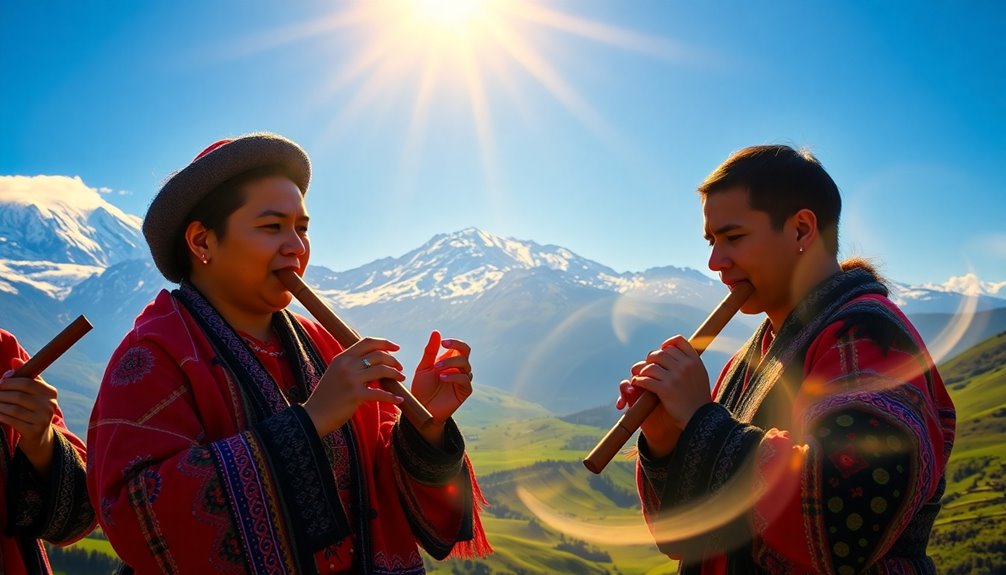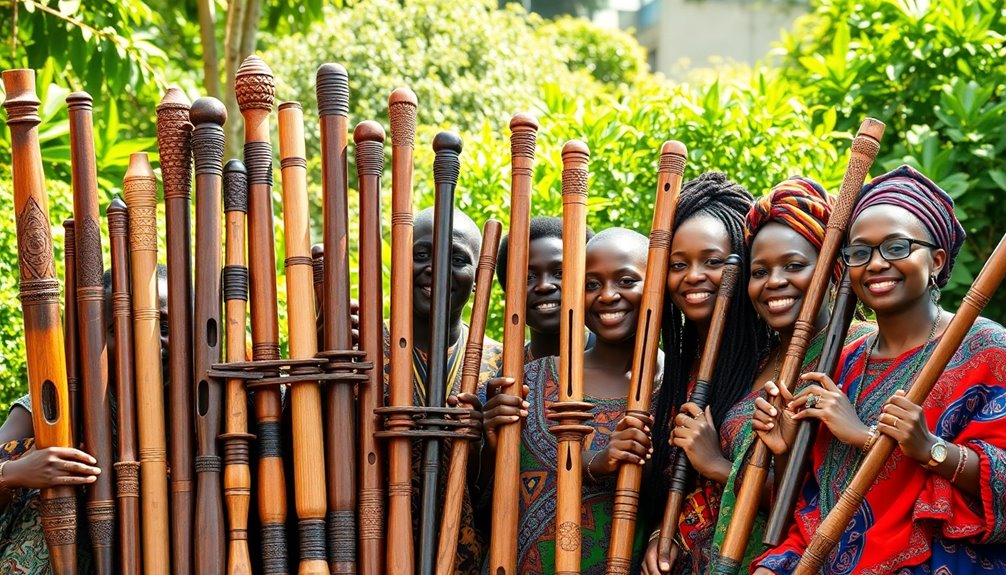Flutes are central to many global traditional music styles, each reflecting unique cultural identities. In Native American traditions, flutes are symbols of connection to nature and spirituality, often featured in storytelling and healing rituals. The Andean pan flute captures communal life with melodies passed down through generations. In Asia, bamboo flutes like the Chinese dizi and Indian bansuri act as storytelling devices, evoking deep emotions. Celtic flutes enhance the lively soundscape, accompanying dance and song. African flute variations showcase creativity and cultural histories. Each tradition is rich with stories, and you'll uncover even more fascinating insights about these musical styles.
Key Takeaways
- Native American flute traditions emphasize connection to nature and spirituality, often used in healing ceremonies and storytelling practices.
- Andean pan flute music features melodies that reflect communal life, with techniques passed down through generations in handcrafted instruments.
- Asian bamboo flute styles, like the Chinese dizi and Indian bansuri, serve as storytelling mediums with distinct emotional qualities across various cultural contexts.
- Celtic whistle and flute traditions combine breath control and finger dexterity, enriching communal experiences through music accompanying traditional dances and singing.
- African flute variations showcase diverse local materials and histories, highlighting creativity and skill through intricate patterns and harmonies in traditional music.
Native American Flute Traditions

When you explore Native American flute traditions, you encounter a rich tapestry of cultural significance and musical expression. The flute, often crafted from wood or bone, symbolizes a connection to nature and the spiritual world. Each note carries the weight of history, embodying stories, emotions, and the essence of Indigenous identity.
In many tribes, the flute plays a pivotal role in healing ceremonies. Its soothing melodies are believed to restore harmony within individuals and communities. When you listen closely, you can feel the intention behind each sound, as flutists channel their spirit and experience into the music. During these ceremonies, the flute serves not only as a musical instrument but also as a conduit for spiritual healing.
Flute symbolism extends beyond mere sound; it represents love, connection, and the cycles of life. Many songs are composed to express feelings for a loved one, making the flute a romantic instrument as well. This duality—its role in healing and in love—highlights the flute's versatility and its integral part in Native American life.
As you investigate deeper into these traditions, you'll discover that the music isn't just about notes; it's about community, storytelling, and the enduring connection between people and their environment. Additionally, the use of flutes in many cultures demonstrates their importance in promoting music literacy and fostering a sense of belonging.
Andean Pan Flute Music

Exploring the Andean pan flute music reveals a vibrant tradition that resonates with the rich cultural heritage of the Andes mountains. This enchanting genre, deeply rooted in Andean folk practices, uses the pan flute, or "zampona," to create melodies that echo the landscape's natural beauty. The pan flute consists of multiple tubes of varying lengths, each producing distinct notes, allowing musicians to express a range of emotions.
As you listen to the rhythmic interweaving of melodies, you'll notice how Andean pan flute music reflects communal life. It often accompanies traditional dances and ceremonies, fostering a sense of belonging among performers and audiences alike. The music serves not just as entertainment, but as a crucial thread that connects individuals to their cultural identity.
The sound of the pan flute can transport you to the high-altitude villages where it's played, inviting you to experience the spirit and resilience of the Andean people. Each note carries stories of ancient traditions, agricultural cycles, and spiritual beliefs, illustrating how music intertwines with daily life.
Moreover, the pan flute transcends generations, as skilled artisans handcraft these instruments, preserving the techniques passed down through families. This careful craftsmanship enhances the music's authenticity, making each performance a shared experience that honors the past while embracing the present. Additionally, the Western Concert Flute is often featured in collaborations with Andean musicians, blending diverse musical styles and enriching cultural expression.
Asian Bamboo Flute Styles

The enchanting sound of the bamboo flute, a staple in many Asian musical traditions, captivates listeners with its warm, earthy tones. You can trace its bamboo flute history back thousands of years, where it served not only as a musical instrument but also as a means of storytelling and cultural expression.
Countries like China, India, and Japan have their own unique styles, each reflecting local customs and spiritual beliefs.
In China, the dizi, a transverse bamboo flute, is integral to traditional bamboo music. Its bright, clear sound often accompanies folk songs and classical performances, evoking images of serene landscapes and bustling markets. You might find it in lively festivals, where its melodies blend seamlessly with the rhythmic beats of drums.
In India, the bansuri—a side-blown bamboo flute—holds a revered position in classical music. Its soulful notes resonate with the emotions of the raga, creating a deep connection between the performer and the audience. Imagine sitting under the stars as the bansuri's sound transports you to another dimension, evoking a sense of belonging to something greater.
In Japan, the shakuhachi, a five-holed bamboo flute, offers a meditative quality, often used in Zen practices. Each breath you take through it becomes a harmonious expression of your inner self, bridging the gap between the material and the spiritual. The maintenance and care of these flutes is essential to preserve their unique sound quality and longevity.
Through these diverse styles, the bamboo flute continues to weave a rich tapestry of cultural heritage, inviting you to explore its enchanting melodies.
Celtic Whistle and Flute

Celebrating the vibrant tones of the Celtic whistle and flute reveals a rich tradition steeped in folklore and community. These instruments, integral to the Celtic soundscape, evoke a sense of belonging that resonates deeply within listeners. The enchanting Celtic melodies, characterized by their lilting rhythms and emotive phrases, transport you to lush green hills and lively gatherings.
When you explore the techniques used in playing the whistle, you'll discover a unique approach that combines breath control and finger dexterity. These whistle techniques allow musicians to produce a wide range of expressive sounds, from gentle whispers to spirited exuberance. The simple yet profound nature of the whistle makes it accessible, inviting you to join the tradition, whether you're a seasoned player or a curious beginner.
The flute, often crafted from wood or metal, enriches the Celtic repertoire with its warm, rich tones. As you listen, you can almost feel the pulse of ancient stories echoing through each note. The interplay between the whistle and flute creates a dialogue that's both harmonious and dynamic, drawing audiences into the heart of the performance. Regular cleaning of these instruments is also crucial to maintaining their sound quality, reflecting the care that musicians have for their craft.
In community settings, these instruments often accompany traditional dances and communal singing, reinforcing the bonds between participants.
African Flute Variations

Celtic melodies may enchant with their lilting rhythms, but the diverse world of African flute variations offers an equally fascinating experience. When you explore African flutes, you'll discover a rich tapestry woven from various cultures and traditions. These instruments, often crafted from local materials like bamboo, wood, or even animal bones, reflect the environment and history from which they arise.
African flute techniques vary widely, showcasing the creativity and skill of the musicians. Some flutes, like the traditional end-blown flutes from East Africa, require precise breath control, allowing you to produce haunting melodies that resonate with the spirit of the land. In contrast, other styles may utilize finger techniques that create intricate patterns and harmonies.
You'll find that each region has its unique methods, whether it's the rich timbre of the Nigerian ogene or the playful notes of the South African umakhweyana. The historical roots of these flutes are embedded in community cultural practices and oral traditions, highlighting their significance in traditional storytelling.
As you immerse yourself in these sounds, consider how they connect to communal rituals, storytelling, and celebrations. The music often serves as a bridge, linking generations and fostering a sense of belonging among the performers and their audiences.
Frequently Asked Questions
How Are Flutes Made in Different Cultures?
When you explore how flutes are made in different cultures, you see a rich tapestry of flute craftsmanship that reflects each society's unique heritage.
Each culture uses local materials, whether bamboo or metal, and employs traditional techniques passed down through generations.
This craftsmanship carries deep cultural significance, embodying stories, rituals, and community ties.
What Are the Health Benefits of Playing the Flute?
Did you know that playing the flute can increase your lung capacity by up to 30%? As you practice, you develop breath control, which not only enhances your playing but also promotes better overall respiratory health.
This rhythmic breathing can reduce stress, boosting your mental health considerably. Engaging with the flute fosters a sense of belonging, connecting you with a community of fellow musicians who share your passion and understanding of this beautiful instrument.
Can Anyone Learn to Play the Flute?
Absolutely, anyone can learn to play the flute! With its accessibility, the flute welcomes beginners of all ages.
Start by choosing a suitable instrument and getting familiar with basic finger placements. Use beginner tips like practicing daily, listening to flute music, and joining local groups for support.
Embrace the learning process, and don't hesitate to ask for help. You'll find joy in playing, and it can lead to a wonderful sense of belonging in the musical community.
How Do Flute Styles Influence Modern Music?
Flute styles greatly influence modern music by introducing unique tonal qualities and improvisational techniques.
When you explore flute improvisation, you can hear how traditional melodies blend into contemporary genres, creating a rich tapestry of sound.
Cultural fusion happens as different styles interact, inspiring new rhythms and harmonies.
This exchange not only enriches your listening experience but also fosters a sense of belonging, connecting you to diverse musical heritages across the globe.
What Materials Are Commonly Used to Make Traditional Flutes?
When you think of a flute, imagine a bridge connecting cultures through sound.
Traditional flutes are often crafted from materials like bamboo, resonating with nature's essence, while metal flutes bring a modern edge to the mix.
Each material influences the flute's voice, shaping the melodies you hear.
Bamboo flutes, warm and earthy, contrast beautifully with the sharp clarity of metal flutes, creating a rich tapestry of auditory experiences that welcomes all who listen.
Conclusion
In exploring the rich tapestry of global traditional music styles featuring flutes, you've uncovered a world where cultures harmonize with nature's breath. Each tradition, from the haunting melodies of Native American flutes to the vibrant sounds of Andean pan flutes, reveals unique narratives and emotional landscapes. As you immerse yourself in these diverse sonic domains, remember that each note carries the essence of its origin, weaving a beautiful mosaic of humanity's shared musical heritage.






